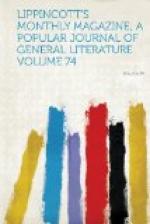Fournier, physiologist, as I have said, by the education of the schools, but by the broader education of his travels sociologist and ethnologist, devoted himself again to science, and framed this hypothesis: Climatic influences, acting upon man, bring about physical changes exceedingly slowly, because they are resisted by an inveterate habit of assimilation. This habit pertains either to the blood or the tissues, possibly to both, probably to the blood alone.
To establish an hypothesis experiment is necessary. Physiology is a science of experiment. Hence the frequent uncertainty of its results, since no two observers conduct an experiment in exactly the same manner—certainly no two ever institute it under precisely the same conditions. Nevertheless, let us not decry science. Out of much searching after truth comes the finding of truth—after long groping in darkness one comes upon a ray of light.
An experiment was necessary. To the ingenious mind of Fournier an elaborate one occurred. If he could perform it, not only would his hypothesis be established and confirmed beyond all cavil, but a, field of scientific research also be opened such as was yet undreamed of. However, for this experiment subjects were needed. Brutes, beasts of the field? Not so: that were easy to achieve. Human beings, two living, healthy men, one white, one black, were the requirements. Impossible! The experiment could never be performed: its requirements were unattainable. O tempora! O mores! Alas, for the degeneracy of the age! In the days of the Roman emperors men were fed, literally fed, to wild beasts in the arena—Gauls, Scythians, Nubians, even Roman freedmen when barbarians were scarce. This to amuse the populace alone. Frightful waste of life! In India, a thousand lives thrown away in a day under the wheels of Juggernaut; in Europe, tens of thousands to gratify the imperious wills of grasping monarchs; in America, hundreds to sate the greed of railroad corporations. And now not two men to be had for an experiment of untold value to science, that would scarcely endanger life in one of them, and in the other would necessitate only the merest scratch! To what are we coming? No one complains that tattooed heads are going out of fashion—that the king of the Cannibal Isles no longer flatters a ship’s master by inquiring which head of all his subjects is ornamented most to his fancy, and the next day sending him that head as a souvenir of his visit to the anthropophagic shores. It is well that the custom is dead. But is there not danger of drifting too far even toward the shore of compassion? May it not be that there is something wrong with the bowels of mercy when criminals are executed barbarously, while science needs their lives, or at least an insight into the method of their dying; when precise examination of the manner of nerve and blood supply to the organs of a superannuated horse is heavily finable; when charitable but perchance too enthusiastic societies for the prevention of cruelty to animals push their earnestness even to interference with scientific researches, because, forsooth! they jeopardize the lives of rabbits, guinea-pigs and dogs? The legend Cave canem bears a deeper meaning now than it did in the inlaid pavements of Pompeian vestibules. We dare not trample it under foot.




